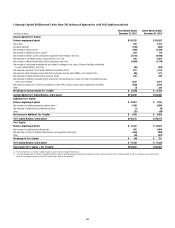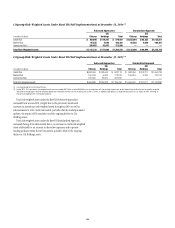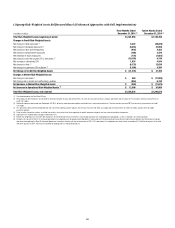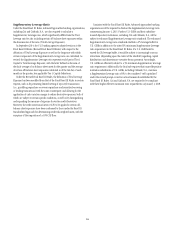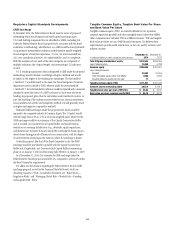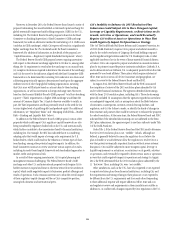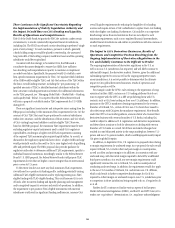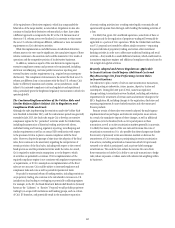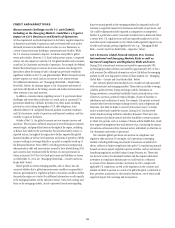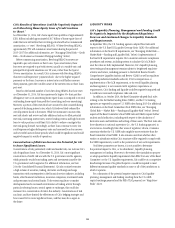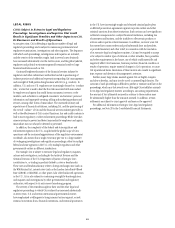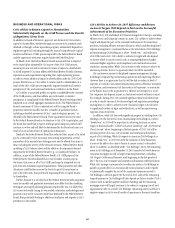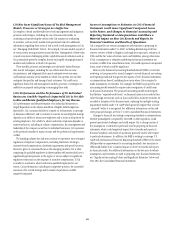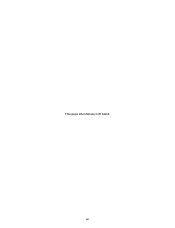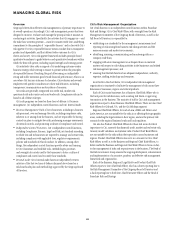Citibank 2014 Annual Report Download - page 75
Download and view the complete annual report
Please find page 75 of the 2014 Citibank annual report below. You can navigate through the pages in the report by either clicking on the pages listed below, or by using the keyword search tool below to find specific information within the annual report.58
CREDIT AND MARKET RISKS
Macroeconomic Challenges in the U.S. and Globally,
Including in the Emerging Markets, Could Have a Negative
Impact on Citi’s Businesses and Results of Operations.
Citi has experienced, and could experience in the future, negative impacts to
its businesses and results of operations, such as elevated credit costs and/or
decreased revenues in its Markets and securities services businesses, as
a result of macroeconomic challenges, uncertainties and volatility. While
the U.S. economy continues to improve, it remains susceptible to global
events and volatility. Moreover, U.S. fiscal and monetary actions, or expected
actions, can also impact not only the U.S. but global markets and economies
as well as Citi’s businesses and results of operations. For example, the Federal
Reserve Board may begin to increase short-term interest rates during 2015.
Speculation about the timing of such a change has previously resulted in
significant volatility in the U.S. and global markets. While Citi expects certain
positive impacts as a result, such as an increase in net interest revenue
(for additional information, see “Managing Global Risk—Market Risk—
Price Risk” below), the ultimate impact to Citi’s businesses and results of
operations will depend on the timing, amount and market and consumer or
other reactions to any such increases.
In addition, concerns remain regarding various U.S. government fiscal
challenges and events that could occur as a result, such as a potential U.S.
government shutdown or default. In recent years, these issues, including
potential or actual ratings downgrades of U.S. debt obligations, have
adversely affected U.S. and global financial markets, economic conditions
and Citi’s businesses, results of operations and financial condition, and they
could do so again in the future.
Outside of the U.S., the global economic recovery remains uneven and
uncertain. The economic and fiscal situations of several European countries
remain fragile, and geopolitical tensions throughout the region, including
in Russia, have added to the uncertainties. Fiscal and monetary actions, or
expected actions, throughout the region have further impacted the global
financial markets as well as Citi’s businesses and results of operations. While
concerns relating to sovereign defaults or a partial or complete break-up of
the European Monetary Union (EMU), including potential accompanying
redenomination risks and uncertainties, seemed to have abated during 2014,
such concerns have resurfaced with the election of a new government in
Greece in January 2015 (for Citi’s third-party assets and liabilities in Greece
as of December 31, 2014, see “Managing Global Risk—Country and Cross-
Border Risk” below).
Slower growth in certain emerging markets, such as China, has also
occurred, whether due to global macroeconomic conditions or geopolitical
tensions, governmental or regulatory policies or economic conditions within
the particular region or country (for additional information on risks specific
to the emerging markets, see the risk factor below). Given Citi’s strategy and
focus on the emerging markets, actual or perceived uncertainty regarding
future economic growth in the emerging markets has impacted and could
continue to negatively impact Citi’s businesses and results of operations, and
Citi could be disproportionately impacted as compared to its competitors.
Further, if a particular country’s economic situation were to deteriorate below
a certain level, U.S. regulators can and have imposed mandatory loan loss
and other reserve requirements on Citi, which could negatively impact its cost
of credit and earnings, perhaps significantly (see, e.g., “Managing Global
Risk—Country and Cross-Border Risk—Argentina” below).
Citi’s Extensive Global Network Subjects It to Various
International and Emerging Markets Risks as well as
Increased Compliance and Regulatory Risks and Costs.
During 2014, international revenues accounted for approximately 58%,
and emerging markets revenues accounted for approximately 40%, of Citi’s
total revenues (for additional information on how Citi defines the emerging
markets as well as its exposures in certain of these markets, see “Managing
Global Risk—Country and Cross-Border Risk” below).
Citi’s extensive global network subjects it to a number of risks associated
with international and emerging markets. These risks can include sovereign
volatility, political events, foreign exchange controls, limitations on
foreign investment, sociopolitical instability, fraud, nationalization or loss
of licenses, sanctions, potential criminal charges, closure of branches or
subsidiaries and confiscation of assets. For example, Citi operates in several
countries that have strict foreign exchange controls, such as Argentina and
Venezuela, that limit its ability to convert local currency into U.S. dollars
and/or transfer funds outside the country. During 2014, Citi discovered
certain frauds involving its Mexico subsidiary, Banamex. There have also
been instances of political turmoil and other instability in certain countries
in which Citi operates, such as in Russia, Ukraine and the Middle East, which
have required management time and attention (e.g., monitoring the impact
of sanctions on Russian entities, business sectors, individuals or otherwise on
Citi’s businesses and results of operations).
Citi’s extensive global operations also increase its compliance and
regulatory risks and costs. For example, Citi’s operations in emerging
markets, including facilitating cross-border transactions on behalf of its
clients, subject it to higher compliance risks under U.S. regulations primarily
focused on various aspects of global corporate activities, such as anti-money-
laundering regulations and the Foreign Corrupt Practices Act. These risks
can be more acute in less developed markets and thus require substantial
investment in compliance infrastructure or could result in a reduction
in certain of Citi’s business activities. Any failure by Citi to comply with
applicable U.S. regulations, as well as the regulations in the countries and
markets in which it operates as a result of its global footprint, could result in
fines, penalties, injunctions or other similar restrictions, any of which could
negatively impact Citi’s earnings and its reputation.


